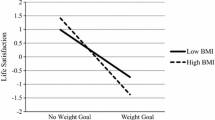Abstract
This study investigated the interrelationships between weight, weight dissatisfaction, restraint, and self-esteem in a group of young adult women and men. The subjects were students at the Flinders University of South Australia, whose student body consists of primarily local students from English-speaking backgrounds. A tentative causal model proposed actual overweight to lead to body dissatisfaction, which causes the person to diet, with the resulting failures leading to loss of self-esteem. This model was confirmed by path analysis for women, but not for men. In line with self-concept theory, subjective overweight was more strongly related to self-esteem for women than for men, with restraint mediating this relationship.
Similar content being viewed by others
References
Bachman, J. G., & O'Malley, P. M. (1977). Self-esteem in young men: A longitudinal analysis of the impact of educational and occupational attainment.Journal of Personality and Social Psychology, 35 365–380.
Baucom, D. H., & Aiken, P. A. (1981). Effect of depressed mood on eating among obese and nonobese dieting and nondieting persons.Journal of Personality and Social Psychology, 41 577–585.
Blanchard, F. A., & Frost, R. O. (1983). Two factors of restraint. Concern for dieting and weight fluctuation.Behavior Research and Therapy, 21 259–267.
Brownell, K. D. (1982). Obesity: Understanding and treating a serious, prevalent, and refractory disorder.Journal of Consulting and Clinical Psychology, 50 820–840.
Crawford, D. A., & Worsley, A. (1988). Dieting and slimming practices of South Australian women.Medical Journal of Australia, 148 325–331.
Fallon, A. E., & Rozin, P. (1985). Sex differences in perceptions of desirable body shape.Journal of Abnormal Psychology, 94 102–105.
Garner, D. M., & Garfinkel, P. E. (1980). Sociocultural factors in the development of anorexia nervosa.Psychological Medicine, 10 647–656.
Garrow, J. S., & Webster, J. (1985). Quetelet's index (W/H2) as a measure of fatness.International Journal of Obesity, 9 147–153.
Heatherton, T. F., Herman, C. P., & Polivy, J. (1991). Effects of physical threat and ego threat on eating behavior.Journal of Personality and Social Psychology, 60 138–143.
Heatherton, T. F., Herman, C. P., Polivy, J., King, G. A., & McGree, S. (1988). The (mis)measurement of restraint: An analysis of conceptual and psychometric issues.Journal of Abnormal Psychology, 97 19–28.
Herman, C. P., & Mack, D. (1975). Restrained and unrestrained eating.Journal of Personality, 43 647–660.
Herman, C. P., & Polivy, J. (1980). Restrained eating. In A. Stunkard (Ed.),Obesity, Philadelphia, PA: Saunders.
Herman, C. P., & Polivy, J., Lank, C., & Heatherton, T. F. (1987). Anxiety, hunger and eating behavior.Journal of Abnormal Psychology, 96 264–269.
Lerner, K. M., Karabenick, S. A., & Stuart, J. L. (1973). Relations among physical attractiveness, body attitudes, and self-concept in male and female college students.Journal of Psychology, 85 119–129.
McCaulay, M., Mintz, L., & Glenn, A. A. (1988). Body image, self-esteem, and depression-proneness: Closing the gender gap.Sex Roles, 18 381–391.
Mintz, L. B., & Betz, N. E. (1986). Sex differences in the nature, realism, and correlates of body image.Sex Roles, 15 185–195.
Polivy, J., & Herman, C. P. (1985). Dieting and binging: A causal analysis.American Psychologist, 40 193–201.
Polivy, J., & Herman, C. P. (1987). Diagnosis and treatment of normal eating.Journal of Consulting and Clinical Psychology, 55 635–644.
Polivy, J., Heatherton, T. F., & Herman, C. P. (1988). Self-esteem, restraint and eating behavior.Journal of Abnormal Psychology, 97 354–356.
Rodin, J., Silberstein, L., & Striegel-Moore, R. (1985). Women and weight. A normative discontent. In T. B. Sonderegger (Ed.),Psychology and Gender. Lincoln: University of Nebraska Press.
Rosenberg, M. (1965).Society and adolescent self-image. Princeton, NJ: Princeton University Press.
Rudeman, A. J. (1983). The restraint scale: A psychometric investigation.Behavior Research and Therapy, 21 253–258.
Silberstein, L. R., Striegel-Moore, R. H., Timko, C., & Rodin, J. (1988). Behavioral and psychological implications of body dissatisfaction: Do men and women differ?Sex Roles, 19 219–232.
Silverstein, B., Peterson, B., & Perdue, L. (1986). Some correlates of the thin standard of bodily attractiveness for women.International Journal of Eating Disorders, 5 895–905.
Stake, J., & Lauer, M. (1987). The consequences of being overweight: A controlled study of gender differences.Sex Roles, 17 31–47.
Striegel-Moore, R. H., Silberstein, L. R., & Rodin, J. (1986). Toward an understanding of risk factors for bulimia.American Psychologist, 41 246–263.
Tiggemann, M. (1992). Body-size dissatisfaction: Individual differences in age and gender, and relationship with self-esteem.Personality and Individual Differences, 13 39–43.
Tiggemann, M., & Pennington, B. (1990). The development of gender differences in body-size dissatisfaction.Australian Psychologist, 25 306–313.
Tiggemann, M., & Rothblum, E. D. (1988). Gender differences in social consequences of perceived overweight in the United States and Australia.Sex Roles, 18 75–86.
Tobin, D. L., Johnson, C., Steinberg, S., Staats, M., & Dennis, A. B. (1991). Multifactorial assessment of bulimia nervosa.Journal of Abnormal Psychology, 100 14–21.
Wolf, N. (1990).The beauty myth. London: Chatto & Windus.
Wooley, O. W., Wooley, S. C., & Dryenforth, S. R. (1979). Obesity and women.Women's Studies International Quarterly, 2 81–92.
Author information
Authors and Affiliations
Additional information
This research was supported by an Australian Research Council Grant.
Rights and permissions
About this article
Cite this article
Tiggemann, M. Gender differences in the interrelationships between weight dissatisfaction, restraint, and self-esteem. Sex Roles 30, 319–330 (1994). https://doi.org/10.1007/BF01420596
Issue Date:
DOI: https://doi.org/10.1007/BF01420596




